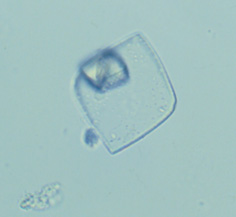Uric acid
Uric acid crystallizes in the orthorombic system. Uric acid crystals can appear under several shapes. The classic crystals are thin rhombus shaped plates with more or less eroded tops. The other forms are the hexagonal plate, the needle and the rosette.
Uric acid crystals usually have a characteristic yellow color. The intensity of the color depends on the thickness of the crystal, thus very thin plates seem colorless, while the massive crystals have a color that tends to be brown. Under polarized light, uric acid shows a polarization color, and with thicker crystals, a series of concentric black lines. The color variation seen under polarized light is quite typical of uric acid.
With rare exceptions, uric acid crystals are of little clinical value and represent a punctual situation.
Amorphous urates
 The amorphous urates seen in urine
specimens and are, most of the time, the result of refrigeration.
A pink pellet after centrifugation is characteristic of amorphous
urates. Under the microscope, amorphous urates appear as
yellow-brown mass of small rounded particles.
The amorphous urates seen in urine
specimens and are, most of the time, the result of refrigeration.
A pink pellet after centrifugation is characteristic of amorphous
urates. Under the microscope, amorphous urates appear as
yellow-brown mass of small rounded particles.
These crystals often adhere to mucus threads and casts. This property sometimes generates structures that mimic the dirty brown cast. Polarized light examination can easily discriminate these urates pseudocasts.
Amorphous urates are of little clinical value.

